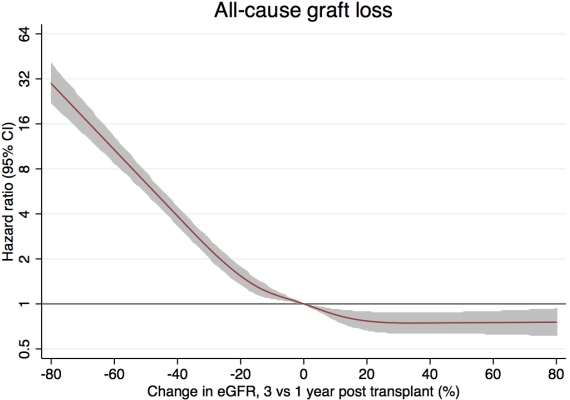Decline in Estimated Glomerular Filtration Rate and Subsequent Risk of Graft Failure and Mortality Among Kidney Transplant Recipients
1Australia and New Zealand Dialysis and Transplant (ANZDATA) Registry, Adelaide, Australia
2Transplantation, Royal Prince Alfred Hospital, Sydney, Australia
3Sydney Medical School, University of Sydney, Sydney, Australia
4Department of Renal Medicine, Sir Charles Gairdner Hospital, Perth, Australia.
Meeting: 2015 American Transplant Congress
Abstract number: 38
Keywords: Graft function, Graft survival, Kidney transplantation, Survival
Session Information
Session Name: Concurrent Session: Kidney Complications: Late Graft Failure
Session Type: Concurrent Session
Date: Sunday, May 3, 2015
Session Time: 2:15pm-3:45pm
 Presentation Time: 3:03pm-3:15pm
Presentation Time: 3:03pm-3:15pm
Location: Terrace IV
Purpose: Graft loss and death are generally late events after kidney transplantation, and trials designed to assess the impact of interventions on these outcomes are currently unfeasible. We examined the relationship between decline in estimated glomerular filtration rate (eGFR) and subsequent graft loss or death on long term follow up of kidney transplant recipients, and thereby examined the utility of eGFR decline as a surrogate end-point.
Methods: We obtained de-identified data from the Australia and New Zealand Dialysis and Transplant (ANZDATA) Registry, and studied 7,949 transplants performed 1995-2009, followed for a total of 71,845 patient-years including 1,121 graft losses and 1,192 deaths. We used adjusted Cox proportional hazards models to examine the relationship between eGFR decline and outcomes, adjusted for potential confounders and baseline eGFR. Percentage change in eGFR was modeled as a restricted cubic spline. The outcomes were all-cause graft loss, death-censored graft failure (return to dialysis or re-transplantation) and patient death.
Results: A 30% or greater decline in eGFR between years 1 and 3 post-transplant was seen in 10% of patients. As compared to those with stable eGFR, a 30% decline in eGFR was strongly associated with all-cause graft loss (hazard ratio [HR] 2.35, 95% CI 2.05-2.69) (figure), death-censored graft failure (HR 3.17, 95% CI 2.63-3.83) and patient death (HR 1.7, 95% CI 1.45-2.06). Greater rates of decline in eGFR were associated with progressively higher HRs for all outcomes.
Conclusions: A 30% decline in eGFR between years 1 and 3 following kidney transplantation is common and is strongly associated with risks of all-cause graft loss, death-censored graft failure and patient death in the longer term. These results closely mirror recent findings in CKD. Percentage decline in eGFR should be considered for use as a surrogate outcome in kidney transplant trials.

To cite this abstract in AMA style:
Clayton P, Lim W, Chadban S. Decline in Estimated Glomerular Filtration Rate and Subsequent Risk of Graft Failure and Mortality Among Kidney Transplant Recipients [abstract]. Am J Transplant. 2015; 15 (suppl 3). https://atcmeetingabstracts.com/abstract/decline-in-estimated-glomerular-filtration-rate-and-subsequent-risk-of-graft-failure-and-mortality-among-kidney-transplant-recipients/. Accessed December 29, 2025.« Back to 2015 American Transplant Congress
